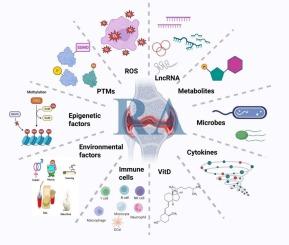探索对类风湿关节炎进展的影响:自身免疫和细胞机制的综合综述
IF 0.9
Q4 GENETICS & HEREDITY
引用次数: 0
摘要
这篇综述揭示了自身免疫与类风湿关节炎(RA)之间的复杂关系,强调了了解促进疾病进展的各种内在和外在因素的重要性。类风湿性关节炎影响着世界上1%的人口,主要影响女性,并表现出关节肿胀和晨僵等临床症状。RF和ACPA等生物标志物用于疾病预后。自身免疫以免疫系统对自身细胞的攻击为特征,导致产生针对自身生物分子的自身抗体,引发细胞损伤和疾病发作。我们的综述旨在全面综合涉及RA进展的无数危险因素,包括遗传、表观遗传、细胞和环境决定因素。这些因素有助于自身抗体的产生并形成RA内的自身免疫环境。通过ACPA和其他自身抗体的存在证明,RA的自身免疫特性引发免疫反应和促炎细胞因子释放,刺激滑膜成纤维细胞活性和关节破坏。此外,侵袭性表观遗传修饰的滑膜成纤维细胞在疾病病理中发挥作用。在本文中,我们强调了了解与RA等自身免疫性疾病相关的免疫耐受改变的重要性,并主张研究其他疾病的类似因素,以增强我们对RA病理生理学的理解。临床研究的进展,如使用RA特异性肽或蛋白质和基于细胞的治疗,显示出改善RA患者预后的希望。总的来说,我们的综述旨在为推动RA进展的复杂机制提供有价值的见解,为治疗干预和疾病管理提供潜在的途径。本文章由计算机程序翻译,如有差异,请以英文原文为准。

Exploring the influences on rheumatoid arthritis progression: A comprehensive review of autoimmunity and cellular mechanisms
This review revealed the complex relationship between autoimmunity and Rheumatoid Arthritis (RA), emphasizing the importance of understanding various intrinsic and extrinsic factors contributing to disease progression. RA, affecting 1 % of the world's population, predominantly impacts females and presents clinical symptoms such as joint swelling and morning stiffness. Biomarkers like RF and ACPA are used for disease prognosis. Autoimmunity, characterized by the immune system's attack on self-cells, leads to the production of autoantibodies against self-biomolecules, initiating cellular impairment and disease onset. Our review aims to comprehensively synthesize the myriad risk factors involved in RA progression, encompassing genetic, epigenetic, cellular, and environmental determinants. These factors contribute to the production of autoantibodies and shape the autoimmune milieu within RA. The autoimmune nature of RA, demonstrated by the presence of ACPA and other autoantibodies, triggers immune responses and proinflammatory cytokine release, stimulating synovial fibroblast activity and joint destruction. Furthermore, aggressive epigenetically modified synovial fibroblasts play a role in disease pathology. In this article, we highlighted the significance of understanding immune tolerance alterations related to autoimmune diseases like RA and advocated for studying similar factors in other diseases to enhance our understanding of RA pathophysiology. Advances in clinical investigations, such as using RA-specific peptides or proteins and cell-based therapies, showed promise in improving RA patient outcomes. Overall, our review aims to provide valuable insights into the intricate mechanisms driving RA progression, offering potential avenues for therapeutic intervention and disease management.
求助全文
通过发布文献求助,成功后即可免费获取论文全文。
去求助
来源期刊

Gene Reports
Biochemistry, Genetics and Molecular Biology-Genetics
CiteScore
3.30
自引率
7.70%
发文量
246
审稿时长
49 days
期刊介绍:
Gene Reports publishes papers that focus on the regulation, expression, function and evolution of genes in all biological contexts, including all prokaryotic and eukaryotic organisms, as well as viruses. Gene Reports strives to be a very diverse journal and topics in all fields will be considered for publication. Although not limited to the following, some general topics include: DNA Organization, Replication & Evolution -Focus on genomic DNA (chromosomal organization, comparative genomics, DNA replication, DNA repair, mobile DNA, mitochondrial DNA, chloroplast DNA). Expression & Function - Focus on functional RNAs (microRNAs, tRNAs, rRNAs, mRNA splicing, alternative polyadenylation) Regulation - Focus on processes that mediate gene-read out (epigenetics, chromatin, histone code, transcription, translation, protein degradation). Cell Signaling - Focus on mechanisms that control information flow into the nucleus to control gene expression (kinase and phosphatase pathways controlled by extra-cellular ligands, Wnt, Notch, TGFbeta/BMPs, FGFs, IGFs etc.) Profiling of gene expression and genetic variation - Focus on high throughput approaches (e.g., DeepSeq, ChIP-Seq, Affymetrix microarrays, proteomics) that define gene regulatory circuitry, molecular pathways and protein/protein networks. Genetics - Focus on development in model organisms (e.g., mouse, frog, fruit fly, worm), human genetic variation, population genetics, as well as agricultural and veterinary genetics. Molecular Pathology & Regenerative Medicine - Focus on the deregulation of molecular processes in human diseases and mechanisms supporting regeneration of tissues through pluripotent or multipotent stem cells.
 求助内容:
求助内容: 应助结果提醒方式:
应助结果提醒方式:


